Observations and Questions regarding Extent Terms in RDA
Observations and Questions regarding Extent Terms in RDA
Observations and Questions regarding Extent Terms in RDA
You also want an ePaper? Increase the reach of your titles
YUMPU automatically turns print PDFs into web optimized ePapers that Google loves.
6JSC/ALA Rep/3April 15, 2011Page 2 of 3My own preference would be to use the same def<strong>in</strong>ition for the s<strong>in</strong>gular <strong>and</strong> plural terms, thusignor<strong>in</strong>g the difference — <strong>and</strong> not add<strong>in</strong>g a plural def<strong>in</strong>ition to the <strong>RDA</strong> Glossary.Question no. 3: Do you agree that we do not need separate def<strong>in</strong>ition of the s<strong>in</strong>gular <strong>and</strong>plural forms, either <strong>in</strong> the Registry or <strong>in</strong> the <strong>RDA</strong> Glossary?Implied vocabularies. The five sub-types of <strong>Extent</strong> do not cover all <strong>RDA</strong> <strong>Extent</strong> statements,only those categories for which there are special <strong>in</strong>structions. The rest are covered by the basic<strong>in</strong>structions on record<strong>in</strong>g extent (3.4.1), which beg<strong>in</strong>s: “Record the extent of the resource bygiv<strong>in</strong>g the number of units <strong>and</strong> an appropriate term for the type of carrier as listed under3.3.1.3 . Record the term <strong>in</strong> the s<strong>in</strong>gular or plural, as applicable.” Thus, although there is noexplicit vocabulary listed under 3.4.1.3, there is an implied vocabulary, consist<strong>in</strong>g of the CarrierType terms listed <strong>in</strong> 3.3.1.3 — m<strong>in</strong>us those covered <strong>in</strong> the explicit lists under the five sub-typesof <strong>Extent</strong> — plus the plural forms of the Carrier Type terms. It would be possible to construct alist of valid terms covered by this <strong>in</strong>struction, for creat<strong>in</strong>g a vocabulary <strong>in</strong> the Registry <strong>and</strong>possibly for addition to 3.4.1.3. As it currently st<strong>and</strong>s, it seems to me that there is a gap<strong>in</strong>g hole<strong>in</strong> the <strong>RDA</strong> <strong>Extent</strong> vocabularies; on the other h<strong>and</strong>, creat<strong>in</strong>g an explicit one does create someredundancy with the Carrier Type vocabulary. I’m <strong>in</strong>cl<strong>in</strong>ed to th<strong>in</strong>k that add<strong>in</strong>g this to theRegistry, but not to <strong>RDA</strong> 3.4.1.3 is a reasonable compromise.Question no. 4: Do you agree with my recommendation <strong>in</strong> the last sentence?Overlapp<strong>in</strong>g vocabularies. My recommendation above does create an overlapp<strong>in</strong>g vocabulary:The general <strong>Extent</strong> vocabulary conta<strong>in</strong>s some of the terms <strong>in</strong> the Carrier Type vocabulary, plusthe plural versions. There is another example of this. The <strong>in</strong>structions for record<strong>in</strong>g <strong>Extent</strong> ofNotated Music (3.4.3.2) <strong>in</strong>struct the cataloger to record “a term for the format of notated musicas listed under 7.20.1.3.” In the Registry, there are two vocabularies, one for <strong>Extent</strong> of NotatedMusic <strong>and</strong> one for Format of Notated Music; the former <strong>in</strong>cludes s<strong>in</strong>gular <strong>and</strong> plural forms, thelatter only the s<strong>in</strong>gular forms. I tend to th<strong>in</strong>k that this overlap is useful, <strong>and</strong> recommend that weagree to this, without add<strong>in</strong>g an explicit list to <strong>RDA</strong> 3.4.3.2.Question no. 5: Do you agree?Fragments of extent statements. The <strong>in</strong>struct<strong>in</strong>g for record<strong>in</strong>g the <strong>Extent</strong> of Text element subtypespecifies a number of th<strong>in</strong>gs that are words that <strong>RDA</strong> says to record as part of an extentstatement, but are only fragments of such statements. For example, approximately, folded, <strong>in</strong>various pag<strong>in</strong>gs, <strong>in</strong>complete, <strong>and</strong> unnumbered. In some cases, one could create a comb<strong>in</strong>edterm, e.g. folded leaves or unnumbered leaves — although there would need to be quite a fewvariants — but approximately <strong>and</strong> <strong>in</strong>complete are not easily treated <strong>in</strong> this way. Note: This is anissue that I expect the CC:DA Task Force to address; one of the th<strong>in</strong>gs that makes data mach<strong>in</strong>eactionableis a congruence between the element <strong>and</strong> the terms — <strong>in</strong> other words, the term shouldst<strong>and</strong> along as the content of the element, not comb<strong>in</strong>ed with other terms or other data such asnumbers.For now, I recommend that we create comb<strong>in</strong>ed terms where appropriate <strong>and</strong> add them to theregistry; we may need to modify the <strong>in</strong>structions <strong>in</strong> <strong>RDA</strong> 3.4.5, but we should try to avoid this if
6JSC/ALA Rep/3April 15, 2011Page 3 of 3the <strong>in</strong>structions are clear that the comb<strong>in</strong>ed term is to be recorded. For the rema<strong>in</strong><strong>in</strong>g fragments,I recommend that we leave these as “new-proposed” until we see whether ALA will propose adifferent structure for this element.Question no. 6: Do you agree with these recommendations?There are also some odds <strong>and</strong> ends, not connected with the <strong>Extent</strong> element:Order of terms. Most of the lists of terms <strong>in</strong> <strong>RDA</strong> give the terms <strong>in</strong> alphabetical order. I noticedthat the list at Format of Notated Music (7.20.1.3) is not <strong>in</strong> alphabetical order. The order isn’tclear, although the general term “score” is at the top of the list.Question no. 7: Does the order matter? Should we rearrange the list at 7.20.1.3 <strong>in</strong>alphabetical order?Hierarchy of Format of Notated Music terms. In the <strong>RDA</strong> Glossary, the entry under “Score”<strong>in</strong>cludes cross-references to all the other Format of Notated Music terms.Question no. 8: Does this imply a hierarchy? Should the Glossary make a dist<strong>in</strong>ctionbetween broader, narrower, <strong>and</strong> related terms? Should we try to build a hierarchy for thisvocabulary either <strong>in</strong> the Registry, the list at <strong>RDA</strong> 7.20.1.3 or both?


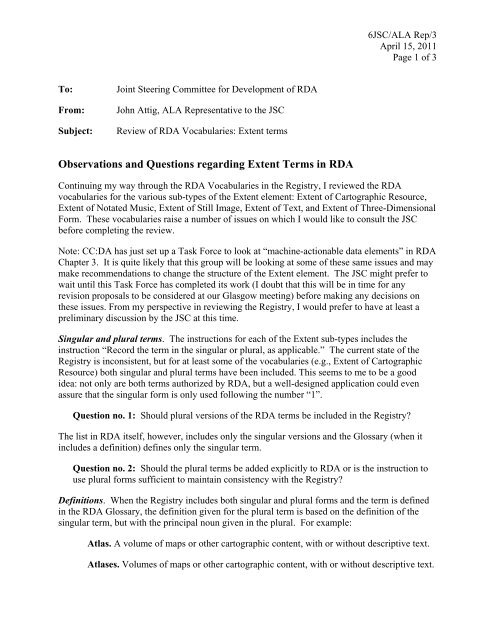


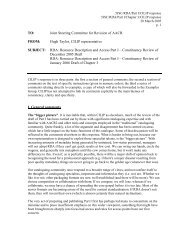
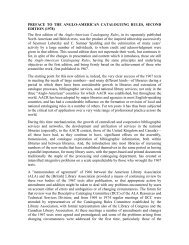
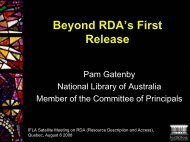


![Presentation slides [PDF] - Joint Steering Committee for ...](https://img.yumpu.com/41621230/1/190x143/presentation-slides-pdf-joint-steering-committee-for-.jpg?quality=85)

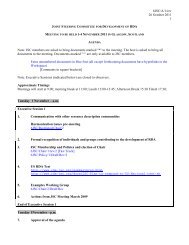
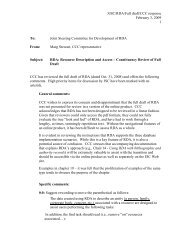
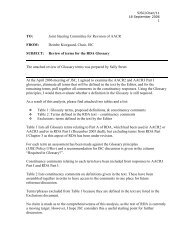
![Presentation slides [PDF] - Joint Steering Committee for ...](https://img.yumpu.com/35256207/1/190x143/presentation-slides-pdf-joint-steering-committee-for-.jpg?quality=85)
